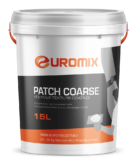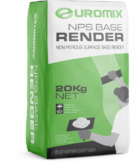Introducing Euromix™ PVC Finishing System

After considerable research, Euromix™ is launching a system that is backed by a 15 Year Warranty*. This new system is the only system recommended and backed by Euromix for application over Dincel and other similar PVC formwork systems.
The Euromix™ Dincel Render Coating System uses full polymer based renders, textures and paints to provide a high performance finish, of 8-12mm total thickness. The system is summarised as follows;
4
Secondary Coat

Euromix™ FP Render
Finishing coat for application of texture and assist on levelling the surface
5
Texture Coat

Euromix™ Texture Coating
Final textured coat and the base colour for the system. Recommended textures Sand Finish and Quartz Texture Coatings to be applied
Euromix™ offers a detailed written specification for every Dincel project, ensuring that the builder, specifier and building owner understand the key steps that the Euromix™ recommended applicator must follow to achieve a coating system that looks great and will not delaminate from the Dincel.
Before applying render, make sure you check the weather forecast!
Render should not be applied during extreme weather events, such as days when temperatures are above 35°c or below 10°c, days when there are high winds (either hot or cold) and days when it is raining. Also, render should not be applied if extreme weather conditions are expected during curing. The weather events, summarised above, all have adverse impact on the setting of the render, either slowing or hastening curing of the render to the point that it does not develop full strength.
As a result, the finished render can crack, delaminate and/or fall off the substrate.
That's too hot!
For rendering, anything above 35°c is considered too hot to handle!
Render applied when the temperature is above 35°c, or, on days when there are high wind strengths, will not cure properly.
In these conditions, water in the render mix is evaporated from the material before it has had the opportunity to form full chemical reactions with the cement, lime and other components.
The result will most likely be a weak, friable render that is likely to crack and peel off the wall.
If freshly applied render is likely to be affected by hot, rapid drying weather then it may need to be actively cured by spraying with a light spray of clean water two or three times a day.
That's too cold!
Do not apply render on frosted substrates or in temperatures below 5°C or if low temperature can be expected during the drying and curing period.
To properly cure render relies on a certain amount of heat being generated in the material as the chemical reactions take place.
Cold weather tends to slow and inhibit the chemical reaction, to the point that the render never fully sets, even after drying.
The result will most likely be a weak, friable render that is likely to crack and peel off the wall.
That's too wet!
Do not apply render during rainfall, or, if rainfall is anticipated during the initial cure.
In normal weather conditions it is advisable to allow 3 to 5 days for render to cure.
In wet weather, where the walling substrate and the render retains high levels of moisture it may be necessary to extend this curing period to 12 to 14 days ... and even then, the render is unlikely to develop full strength!
Do not allow rain to strike newly applied material and do not render onto saturated backgrounds. Both these conditions will impair bond strength and may encourage the phenomenon of efflorescence ... lime staining of the render. Exposure to rain is not the only issue - run-off from roofs, drainage or wind driven moisture during curing, can also cause render failure!
Obviously extra attention should be paid to areas close to the ground and at the bottom of walls - substrates in these areas are often more saturated than other areas - they may require longer to dry. Where you have been able to apply render to dry substrates and when rain is imminent, remember to shield the coating from moisture getting onto the finished surface and stop moisture getting into the substrate as well - for at least 24 hours!
©2021 Euromix. All rights reserved | Terms of Service | Privacy Policy



